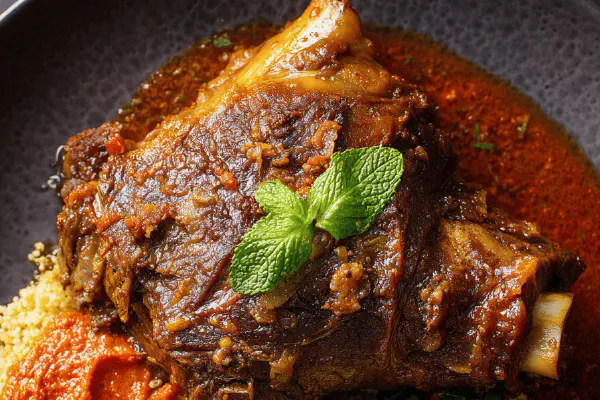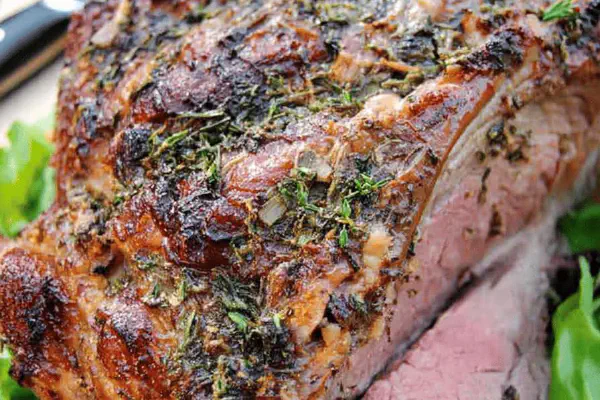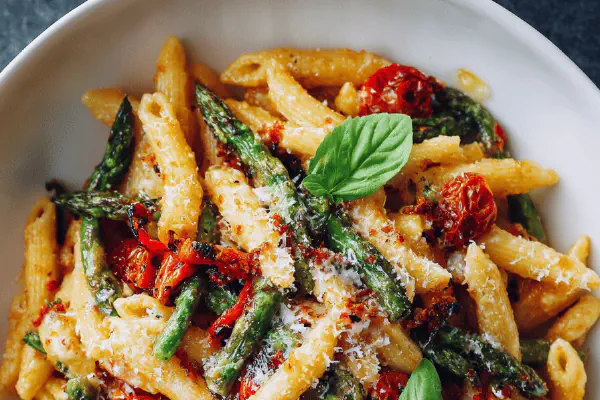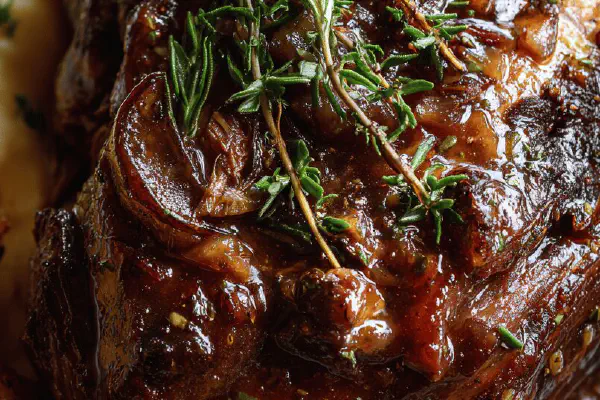Mediterranean Lamb Leg Roast

By Emma
Certified Culinary Professional
Ingredients
- 2 kg boneless leg of lamb, trimmed of excess fat (4 lb)
- 50 ml extra virgin olive oil (3 tbsp)
- 2 medium onions, finely chopped
- 3 garlic cloves, minced
- 25 ml tomato paste (1 generous tbsp)
- 20 ml liquid honey or agave syrup
- 5 ml harissa paste (1 tsp)
- 2.5 ml crushed fenugreek seeds
- 2.5 ml whole cumin seeds, lightly crushed
- 2.5 ml ground turmeric
- 150 ml vegetable or chicken stock
- 150 ml dry red wine, good quality
- Sea salt and freshly ground black pepper to taste
About the ingredients
Method
- Set oven rack mid-level. Heat to 160 °C / 320 °F. Lower than usual to slow-cook, keep lamb tender.
- Heat half the olive oil in a large ovenproof skillet. Brown lamb evenly until dark crust forms — 5 to 7 minutes. Skin should snap when poked; deep color means flavor locked in. Salt and pepper now, not later.
- Remove lamb. In leftover oil, soften onions and garlic gently over medium heat, stirring. Wait for onions turning translucent and silk-like, about 7–8 minutes. Watch for the smell — that sweet, pungent base forming; key step skipped and you get harsh raw notes.
- Stir in tomato paste, honey, harissa, fenugreek, cumin, and turmeric. Mix well to release spices. Salt and pepper again. Let cool slightly. The mixture will thicken and deepen in aroma.
- Return lamb to pan. Spoon onion-spice mixture over the roast, coat thoroughly. Pour broth and wine carefully around, not on top — keep paste intact.
- Cover pan tightly with foil—trap steam but don’t smother. Roast 1 h 40 min; check broth levels occasionally—add splash if evaporates too fast.
- Remove foil, raise heat to 180 °C / 355 °F, roast uncovered 25 minutes more or until internal temperature hits 56 °C / 133 °F for medium-rare. Probe with a thermometer or press with finger; meat should yield but still have resistance.
- Rest uncovered, tent loosely with foil, 20 minutes. Temperature will rise few degrees; juices redistribute, don’t skip this or meat ends dry.
- Cut strings, slice thin against grain; juicy, tender, pink with crisp edges. Serve immediately with couscous tossed with chopped mint, diced green apple for freshness, maybe a drizzle of lemon juice.
- If lacking a thermometer, look for juices beginning to emerge clear, not blood-red—a good indicator lamb’s perfect pink.
Cooking tips
Chef's notes
- 💡 Brown lamb gently over medium heat; listen for that faint snap when poked; dark crust means juices sealed. Avoid too hot or oil smoking. Crowding pan steams meat, not crusting it. Timing critical—5 to 7 minutes max. Salt early here locks flavor inside; skip and it’s bland core later.
- 💡 Onions and garlic softening slow; no rush. Medium heat, gently stirring; watch smell change from sharp to sweet, pungent base. Translucent, silk-like texture signals ready. If skipped, raw garlic sharpness ruins layers. Take 7 to 8 minutes. Add tomato paste off heat or very low—prevents bitterness from burning tomato sugars.
- 💡 Mix spices well into tomato paste blend before returning lamb. Fenugreek seeds replace usual coriander seeds—pungent, earthy, almost maple-like bitterness balancing honey’s sweetness. Use cumin whole, lightly crushed; smokier than mustard seeds, better fit here. Don’t overdo harissa; too much smothers, too little loses warmth.
- 💡 Pour broth and wine cautiously around meat edges, not on paste layer. Keeps paste intact on roast surface. Cover tightly with foil to trap steam; lamb cooks moist but crust won’t vanish. If broth evaporates too fast, add water or more broth. Lengthen covered cooking if lamb thicker. Remove foil for last 25 minutes to deepen crust and hit medium-rare temp 56 °C.
- 💡 Rest meat uncovered, tent loosely with foil, 20 minutes minimum. Crucial step—juices redistribute, temperature rises from 56 to around 63 °C. Skip resting; meat dries out. Slice thin, against grain. Juicy, tender with pink center and crisp edges. Serve with mint-apple couscous or herb salad to cut richness; lemon juice drizzle recommended.
Common questions
How to check doneness without thermometer?
Press lamb gently with finger, feel resistance; tender but springy not squishy. Or watch juice color when slicing—clear, not pink/red. Cuts safe margin but thermometer best. Also look for crust color, internal heat fades pink edges if overcooked.
Can I substitute fenugreek seeds?
Fenugreek pungent, maple-like; no direct equals. If unavailable, try a mix cumin plus ground mustard but lose some bitterness edge. Coriander gives citrus notes, so skip if wanting earthy bitter layer here. Fresh fenugreek leaves different, do not swap.
What if broth evaporates too fast?
Add splash water or extra broth, keep pan moist. Prevents drying out. Watch levels closely first hour. Slow heat key; too hot burns onion-spice coating. Foil cover traps steam moisture, extend covered time if needed. Too much wine dilutes paste; pour slowly.
How to store leftovers?
Wrap tightly, fridge up to 3 days. Reheat gently in oven covered to keep moist. Freeze slices in vacuum bags or airtight containers max 2–3 months. Sauce thickens over time, add splash broth or water when reheating. Avoid microwave unless careful, dries edges fast.



